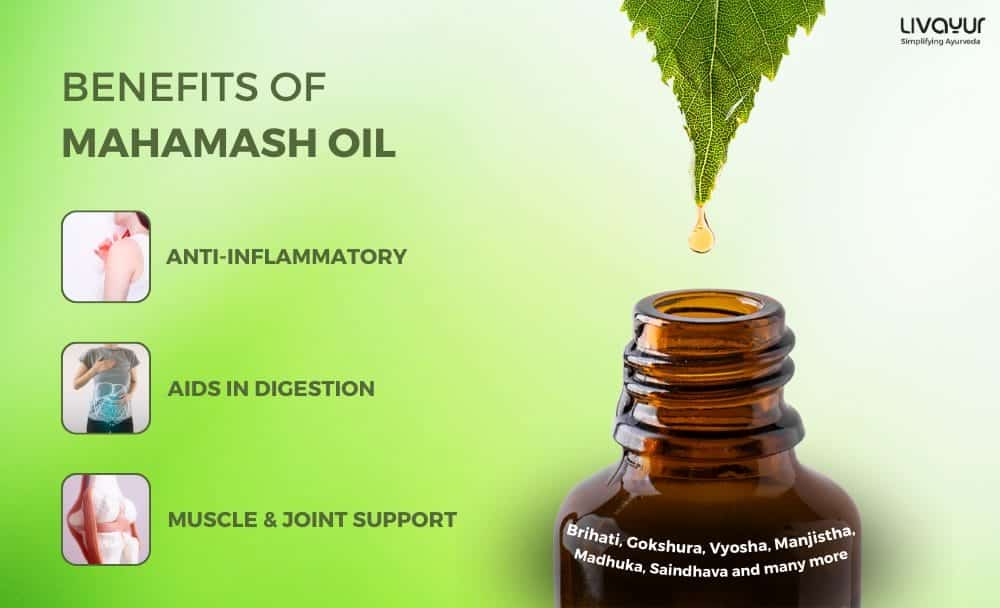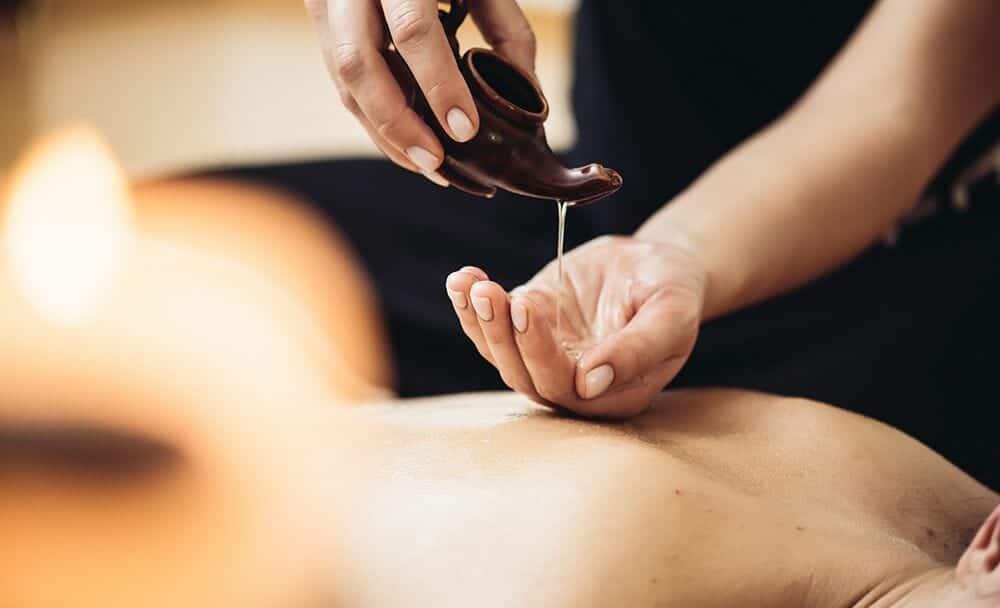
Mahamash Oil is a traditional Ayurvedic formulation that has gained immense popularity for its several health benefits. Derived from a blend of various natural ingredients, this oil has been used for centuries in Ayurveda, the ancient Indian system of medicine. Mahamash Taila finds mention in the Ayurvedic classical text “Sarvang Sundar Rasa” and is described in “Vangasena Vatavyadhi Adhyay.” These texts elaborate on the oil’s properties and its combination with rasakalpa. The synergistic effects of these ingredients exhibit potent vedanasthapaka (pain-relieving), vatashamaka (pacifying Vata), and Amapachana (digestive) properties, aiding in the disruption of Amavata’s disease process. Using Mahamash Tail in Amavata cases demonstrates notable improvement in signs and symptoms post-treatment. [1]
This comprehensive guide will explore the elements, benefits, mahamash tail uses in Hindi, dosage, and potential side effects of Mahamash Oil.
Ingredients of Mahamash Oil
Mahamash Oil is crafted using potent herbal ingredients that work synergistically to provide various health benefits. While formulations may vary slightly, some common ingredients found in Mahamash Oil include:
- Black Gram – Phaseolus mungo
- Goat meat – Chaga mamsa
- Atmagupta – Mucuna pruriens
- Urubaka – Castor root – Ricinus communis
- Shatahva – Anethum sowa
- Lavanatraya – Combination of three salts – rock salt, sochal salt, common salt
- Jeevaneeya group of herbs – Manjishta – Rubia cordifolia, Chavya – Piper chaba, Chitraka – Plumbago zeylanica, Katphala – Myrica nagi
- Vyosha – Trikatu – Pepper, long pepper, and ginger
- Rasna – Pluchea lanceolata
- Madhuka – Licorice – Glycyrrhiza glabra
- Saindhava – Rock salt
- Devadaru – Cedrus deodara
- Amrita – Tinospora cordifolia
- Kushta – Saussurea lappa
- Ashwagandha – Withania somnifera
- Vacha – Acorus calamus
- Shati – Hedychium spicatum
- Cow Milk
- Tilataila (oil of Sesamum indicum)
- Dashamoola:
Bilva – Aegle marmelos
Agnimantha – Premna mucronata
Shyonaka – Oroxylum indicum
Gambhari – Gmelina arborea
Patala – Stereospermum suaveolens
Shalaparni – Desmodium gangeticum
Prishniparni – Uraria picta
Gokshura – Tribulus terrestris
Brihati – Solanum indicum
Kantakari – Solanum xanthocarpum [2]
Benefits of Mahamash Oil
The blend of ingredients in the oil gives rise to several Mahamash oil benefits:
Anti-inflammatory:
Each ingredient exhibits a kaphavaatshamak (balancing Kapha and Vata) effect. The primary cause of swelling (shoth) is the combination of Kapha and Vata imbalance. Therefore, these medications prove highly efficacious in managing Amavata (a condition characterized by joint inflammation due to toxins and Vata imbalance). [1]
Muscle and Joint Support:

Mahamash Oil is often used to promote healthy muscles and joints. It is believed to provide nourishment to the muscles and support joint flexibility, particularly because of the anti-osteoarthritic activity of Vigna. [2]
Pain alleviation:
Mahamash Oil is considered to have rejuvenating properties that help alleviate pain and enhance vitality.[2]
Aids in digestion:
Mahamash Tel consists of components that possess aampachak (digestive), jwarghna (fever-relieving), ushna virya (warming potency), and katu vipakatmak (pungent post-digestive effect) properties. These constituents are readily absorbable and effectively assist to diminish ama. [1]
Other benefits:
The Thailam is an Ayurvedic oil blend employed in massage therapy to address conditions like paralysis, facial palsy, deafness, tinnitus, headaches, as well as joint discomfort linked to lumbar and cervical spondylitis. It also finds application in managing Duchenne’s muscular dystrophy and other neurological conditions. [2]
Uses of Mahamash Oil
Mahamash Oil is commonly used in Ayurvedic practices for various purposes. The oil mitigates Vata without provoking Kapha imbalance. It fosters bodily vigor and imparts muscle resilience. The oil adeptly assimilates the attributes of supplementary substances during the Sneha paka (processing of oil) without compromising its inherent qualities, according to the Charka Samhita Sutrasthan. [3] Here are some of the Mahamash oil uses.
Massage:

The oil is often used for therapeutic massage to support muscle and joint health. Massaging the oil onto the affected areas is believed to relieve discomfort. [2]
Joint Stiffness:
Mahamash Oil is used to alleviate stiffness in the joints and promote flexibility [2]. The oil can relieve pain and swelling, as well as relax the muscles and improve the overall quality of life. [3]
Muscle wasting:
Yet another of the mahamash oil uses in Hindi is to decrease bahu sosha or muscle fatigue in the forearm. [3]
Dosage of Mahamash Oil
The dosage of Mahamash Oil may vary based on individual needs and the specific instructions a qualified Ayurvedic practitioner provides. The oil is generally applied externally through massage onto the affected areas. In the case of oral administration, 5 to 10 drops of the oil can be taken one or two times a day before meals with hot water. [4]
FAQs
• What are the side effects of Mahamash Oil?
When used as directed and under the guidance of a qualified practitioner, Mahamash Oil is generally considered safe. However, some individuals may experience skin sensitivity or irritation. A patch test before using the oil extensively to check for any adverse reactions is advised. Pregnant women and lactating moms should consult a healthcare professional before using Mahamash Oil. Also, people with diabetes, hypercholesterolemia, and high BP should exercise precautions while taking it orally.
• Is Mahamash oil good for the hair?
Yes, the oil is recognized for its ability to nourish both the hair and scalp, enhancing hair strength, diminishing hair loss, and enhancing the overall health of the hair.
• How is Mahamash oil good for the skin?
Mahamash Oil serves as an excellent ally for your skin. Its hydrating attributes guard against dryness and provide nourishment, resulting in a supple and luminous complexion. The regular application maintains the skin’s innate moisture equilibrium, fostering a vibrant and healthy appearance.
• Which is the best product in the market containing Mahamash oil?
Mahamash oil is known for its pain relief properties. It is also great for alleviating arthritis-related conditions like joint stiffness, inflammation, etc. Zandu Seniorz Pain Relief Oil is composed of the best quality Ayurvedic ingredients to bring you relief from muscular pain and osteoarthritis pain. The oil is made of potent pain relief ingredients like Mahamash Oil, Mahanarayan Oil, and Sunthi Oleoresin. Visit Zanducare.com to order it without delay & get a pain-free life!
Conclusion
Mahamash Oil is a traditional Ayurvedic formulation that combines various natural ingredients to benefit muscle and joint health. It is commonly used in therapeutic massage and is believed to have rejuvenating and nourishing properties.
Disclaimer:
This article is written from a health and wellness perspective and is not medical advice. Kindly seek the help of a certified medical practitioner before initiating any treatment.
References:
- The The role of Sarvang sundar rasa Orally and Mahamash tail locally in the management of Amavata WSR to Rheumatoid Arthritis –A case study.
- THE GC MS STUDY OF ONE AYURVEDIC Pain relieving OIL “Mahamasha thailam”
- Anti-inflammatory and Analgesic Activity of an Ayurvedic Liniment Formulation
- Mahamasha Thailam Benefits, Usage, Indications and Dosage



















